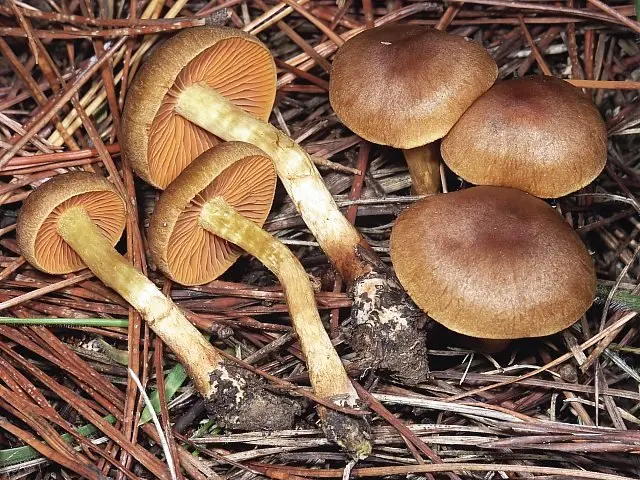Contents
Cinnamon cobweb (Cortinarius cinnamomeus)
- Division: Basidiomycota (Basidiomycetes)
- Subdivision: Agaricomycotina (Agaricomycetes)
- Class: Agaricomycetes (Agaricomycetes)
- Subclass: Agaricomycetidae (Agaricomycetes)
- Order: Agaricales (Agaric or Lamellar)
- Family: Cortinariaceae (Spiderwebs)
- Genus: Cortinarius (Spiderweb)
- Type: Cortinarius cinnamomeus (Cinnamon cobweb)
- Flammula cinnamomea;
- Gomphos cinnamomeus;
- Dermocybe cinnamomea.

Cinnamon cobweb (Cortinarius cinnamomeus) is a species of mushrooms belonging to the Spider Web family, the Spider Web genus. This mushroom is also called cobweb brown, or cobweb dark brown.
cobweb brown also called the species Cortinarius brunneus (Dark-brown cobweb), not related to this.
External Description
Cinnamon cobweb has a hat with a diameter of 2-4 cm, characterized by a hemispherical convex shape. Over time, the hat becomes open. In its central part there is a noticeable blunt tubercle. To the touch, the surface of the cap is dry, fibrous in structure, yellowish-brown-brown or yellowish-olive-brown in color.
The mushroom stem is characterized by a cylindrical shape, initially well filled inside, but gradually becomes hollow. In girth, it is 0.3-0.6 cm, and in length it can vary from 2 to 8 cm. The color of the leg is yellowish-brown, brightening towards the base. The pulp of the mushroom has a yellow tint, sometimes turning into olive, it has no strong smell and taste.
The hymenophore of fungi is represented by a lamellar type, consisting of adherent yellow plates, gradually becoming brownish-yellow. The color of the plate is similar to a mushroom cap. In structure, they are thin, often located.
Season and habitat
Cinnamon cobweb begins fruiting in late summer and continues to produce throughout September. It grows in deciduous and coniferous forests, is widely distributed in the boreal zones of North America and Eurasia. Occurs in groups and singly.
Edibility
The nutritional properties of this type of mushroom are not fully understood. The unpleasant taste of the pulp of the cinnamon cobweb makes it unsuitable for human consumption. This mushroom has several related species, distinguished by their toxicity. However, no toxic substances were found in the cinnamon cobweb; it is absolutely safe for human health.
Similar types and differences from them
One of the cinnamon spider web species of mushrooms is the saffron cobweb. Their main difference from each other is the color of the hymenophore plates in young fruiting bodies. In cinnamon gossamer, the plates have rich orange hues, while in saffron, the color of the plates gravitates more towards yellow. Sometimes there is confusion with the name of the cinnamon cobweb. This term is often called the dark brown cobweb (Cortinarius brunneus), which is not even among the species related to the cobweb described.
An interesting fact is that cinnamon cobweb has the properties of coloring materials. For example, with the help of its juice, you can easily dye wool in a rich burgundy-red color.









